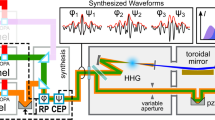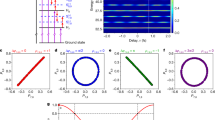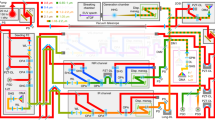Abstract
The development of attosecond pulses across different photon energies is an essential precursor to performing pump–probe attosecond experiments in complex systems, where the potential of attosecond science1 can be further developed2,3. We report the generation and characterization of synchronized extreme ultraviolet (90 eV) and vacuum ultraviolet (20 eV) pulses, generated simultaneously via high-harmonic generation. The vacuum ultraviolet pulses are well suited for pump–probe experiments that exploit the high photo-ionization cross-sections of many molecules in this spectral region4 as well as the higher photon flux due to the higher conversion efficiency of the high harmonic generation process at these energies5. We temporally characterized all pulses using the attosecond streaking technique6 and the FROG-CRAB retrieval method7. We report 576 ± 16 as pulses at 20 eV and 257 ± 21 as pulses at 90 eV. Our demonstration of synchronized attosecond pulses at different photon energies, which are inherently jitter-free due to the common-path geometry implemented, offers unprecedented possibilities for pump–probe studies.
This is a preview of subscription content, access via your institution
Access options
Subscribe to this journal
Receive 12 print issues and online access
$209.00 per year
only $17.42 per issue
Buy this article
- Purchase on Springer Link
- Instant access to full article PDF
Prices may be subject to local taxes which are calculated during checkout



Similar content being viewed by others
References
Krausz, F. & Ivanov, M. Attosecond physics. Rev. Mod. Phys. 81, 163–234 (2009).
Dutoi, A. D. & Cederbaum, L. S. Time-resolved pump–probe spectroscopy to follow valence electronic motion in molecules: application. Phys. Rev. A 90, 023414 (2014).
Tzallas, P., Skantzakis, E., Nikolopoulos, L. A. A., Tsakiris, G. D. & Charalambidis, D. Extreme-ultraviolet pump–probe studies of one-femtosecond-scale electron dynamics. Nature Phys. 7, 781–784 (2011).
Kameta, K., Kouchi, N., Ukai, M. & Hatano, Y. Photoabsorption, photoionization, and neutral-dissociation cross sections of simple hydrocarbons in the vacuum ultraviolet range. J. Electron Spectrosc. Relat. Phenom. 123, 225–238 (2002).
L'Huillier, A., Schafer, K. J. & Kulander, K. C. Theoretical aspects of intense field harmonic generation. J. Phys. B 24, 3315 (1991).
Itatani, J. et al. Attosecond streak camera. Phys. Rev. Lett. 88, 173903 (2002).
Mairesse, Y. & Quéré, F. Frequency-resolved optical gating for complete reconstruction of attosecond bursts. Phys. Rev. A 71, 011401 (2005).
Sansone, G. et al. Isolated single-cycle attosecond pulses. Science 314, 443–446 (2006).
Mashiko, H. et al. Double optical gating of high-order harmonic generation with carrier-envelope phase stabilized lasers. Phys. Rev. Lett. 100, 103906 (2008).
Ferrari, F. et al. High-energy isolated attosecond pulses generated by above-saturation few-cycle fields. Nature Photon. 4, 875–879 (2010).
Witting, T. et al. Sub-4-fs laser pulse characterization by spatially resolved spectral shearing interferometry and attosecond streaking. J. Phys. B 45, 074014 (2012).
Popmintchev, T. et al. Bright coherent ultrahigh harmonics in the keV X-ray regime from mid-infrared femtosecond lasers. Science 336, 1287–1291 (2012).
Mashiko, H. et al. Tunable frequency-controlled isolated attosecond pulses characterized by either 750 nm or 400 nm wavelength streak fields. Opt. Express 18, 25887 (2010).
Beutler, M., Ghotbi, M. & Noack, F. Generation of intense sub-20-fs vacuum ultraviolet pulses compressed by material dispersion. Opt. Lett. 36, 3726–3728 (2011).
Graf, U. et al. Intense few-cycle light pulses in the deep ultraviolet. Opt. Express 16, 18956–18963 (2008).
Reiter, F. et al. Generation of sub-3 fs pulses in the deep ultraviolet. Opt. Lett. 35, 2248–2250 (2010).
Chini, M. et al. Coherent phase-matched VUV generation by field-controlled bound states. Nature Photon. 8, 437–441 (2014).
Kim, K. T., Ko, D. H., Park, J., Tosa, V. & Nam, C. H. Complete temporal reconstruction of attosecond high-harmonic pulse trains. New J. Phys. 12, 083019 (2010).
Russell, P. S. J., Hölzer, P., Chang, W., Abdolvand, A. & Travers, J. C. Hollow-core photonic crystal fibres for gas-based nonlinear optics. Nature Photon. 8, 278–286 (2014).
Feng, X. et al. Generation of isolated attosecond pulses with 20 to 28 femtosecond lasers. Phys. Rev. Lett. 103, 183901 (2009).
Henkel, J. et al. Prediction of attosecond light pulses in the VUV range in a high-order-harmonic-generation regime. Phys. Rev. A 87, 043818 (2013).
Bothschafter, E. M. et al. Collinear generation of ultrashort UV and XUV pulses. Opt. Express 18, 9173–9180 (2010).
Brizuela, F. et al. Efficient high-order harmonic generation boosted by below-threshold harmonics. Sci. Rep. 3, 1410 (2013).
Frank, F. et al. Invited review article: technology for attosecond science. Rev. Sci. Instrum. 83, 071101 (2012).
Gagnon, J., Goulielmakis, E. & Yakovlev, V. S. The accurate FROG characterization of attosecond pulses from streaking measurements. Appl. Phys. B 92, 25–32 (2008).
Goulielmakis, E. et al. Single-cycle nonlinear optics. Science 320, 1614–1617 (2008).
Chini, M., Wang, H., Khan, S. D., Chen, S. & Chang, Z. Retrieval of satellite pulses of single isolated attosecond pulses. Appl. Phys. Lett. 94, 161112 (2009).
Palatchi, C. et al. Atomic delay in helium, neon, argon and krypton. J. Phys. B 47, 245003 (2014).
Robinson, J. S. et al. The generation of intense, transform-limited laser pulses with tunable duration from 6 to 30 fs in a differentially pumped hollow fibre. Appl. Phys. B 85, 525–529 (2006).
Okell, W. A. et al. Carrier-envelope phase stability of hollow fibers used for high-energy few-cycle pulse generation. Opt. Lett. 38, 3918–3921 (2013).
Henke, B. L., Gullikson, E. M. & Davis, J. C. X-ray interactions: photoabsorption, scattering, transmission, and reflection at E = 50–30,000 eV, Z = 1–92. At. Data Nucl. Data Tables 54, 181–342 (1993).
Lynch, D. W. & Hunter, W. R. in Handbook of Optical Constants of Solids (ed. Palik, E. D.) 233–286 (Academic, 1997).
Acknowledgements
This work was supported financially by the Engineering and Physical Sciences Research Council (EPSRC) through grant (UK)EP/I032517/1, by the European Research Council (ERC) through ASTEX project 290467, and by the Deutsche Forschungsgemeinschaft through grant no. LE 2163/6-1. The authors thank N. Powell, A. Gregory and P. Ruthven for technical support.
Author information
Authors and Affiliations
Contributions
D.F. and T.W. contributed equally as first authors. D.F. and T.W. performed (with contributions from W.A.O.) the streaking experiments. J.W.G.T. and J.P.M. conceived and designed the experiment. P.M.-H. and D.J.W. performed the absolute photon flux calibration. J.H. and M.L. provided the TDSE calculations and theoretical support. D.F. performed the analysis of the data. D.F., J.W.G.T. and J.P.M. wrote the manuscript with contributions from T.W., T.R.B., J.H. and W.A.O. All authors discussed the results and the analysis of the data.
Corresponding author
Ethics declarations
Competing interests
The authors declare no competing financial interests.
Supplementary information
Supplementary information
Supplementary information (PDF 330 kb)
Rights and permissions
About this article
Cite this article
Fabris, D., Witting, T., Okell, W. et al. Synchronized pulses generated at 20 eV and 90 eV for attosecond pump–probe experiments. Nature Photon 9, 383–387 (2015). https://doi.org/10.1038/nphoton.2015.77
Received:
Accepted:
Published:
Issue Date:
DOI: https://doi.org/10.1038/nphoton.2015.77
This article is cited by
-
Experimental demonstration of attosecond pump–probe spectroscopy with an X-ray free-electron laser
Nature Photonics (2024)
-
Effect of high slice energy spread of an electron beam on the generation of isolated, terawatt, attosecond X-ray free-electron laser pulse
Scientific Reports (2020)
-
Hollow core optical fibres with comparable attenuation to silica fibres between 600 and 1100 nm
Nature Communications (2020)
-
Attosecond streaking measurement of extreme ultraviolet pulses using a long-wavelength electric field
Scientific Reports (2016)



